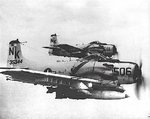Lucky13
Forum Mascot
Considering that they planned to bring the AD back into production back in the day, they didn't only because it would have cost too much. How well does the Skyraider stand with other attack aircraft after WWII and how would she fair today, in air to ground combat?



